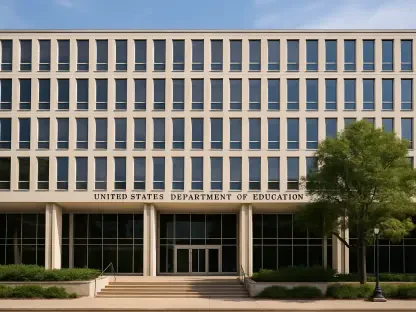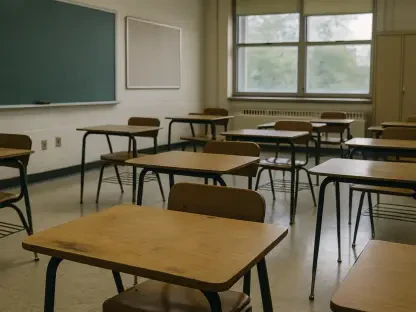In an unprecedented move, the U.S. Department of Education, under the Trump administration, mandated a comprehensive reassessment of diversity, equity, and inclusion (DEI) practices within K-12 schools to qualify for federal funding. Issued last Thursday, the directive provided schools and states with a tight 10-day deadline to agree to a certification process, demonstrating the administration’s forceful approach towards DEI policies. The initiatives aimed at fostering equitable treatment for all demographics have come under scrutiny, with former President Trump arguing that these measures discriminate against certain groups.
Federal Funding Tied to DEI Policy Compliance
The Certification Requirement
Craig Trainor, acting assistant secretary for civil rights, asserted that receiving federal financial assistance is a significant privilege, and he accused several schools of misapplying DEI programs to benefit specific groups disproportionately. According to the administration’s analysis, such practices could infringe upon federal civil rights laws. Consequently, schools must comply with rigorous legal and analytical requirements detailed in the new certification process. Failure to meet these conditions threatens vital federal funds, particularly Title I funding, which substantially supports low-income communities and accounts for billions of dollars annually.
Chicago Public Schools (CPS), for example, anticipated receiving nearly $400 million in Title I funding this year. Expressing concerns, Mayor Brandon Johnson vowed to defend educational integrity and the interests of the students affected by this mandate. The Illinois State Board of Education (ISBE) also criticized the administration’s measure, describing it as a coercive tool that imposes undue power over school districts across the nation. Despite the federal directive, Illinois remains committed to fostering inclusive education for children from diverse backgrounds.
Impacts on Illinois and Beyond
In the broader jurisdiction, the Education Department’s recent actions include retracting Illinois schools’ authorization to utilize $77 million in federal pandemic relief funds. This decision has imposed a stringent reapplication process for the reinstatement of such funds. Originally, this funding was earmarked for essential services such as transportation for homeless children and tutoring to mitigate learning losses. A memo previously circulated by the department underscored that school policies providing differential treatment based on race are unlawful, addressing grievances of perceived bias against white and Asian American students.
The ramifications of withdrawing these funds are potentially severe, particularly for schools in high-need areas. Illinois has vocalized continued dedication to serving its student population despite the restriction of these funds. The withdrawal of federal pandemic relief funds might further strain the resources of these districts, highlighting the contentious relationship between federal directives and state-level educational objectives. While some schools may seek alternative funding sources, others are in immediate need of the now inaccessible federal support.
State and Local Responses
School Districts’ Stance
School districts nationwide have echoed concerns similar to those expressed by Illinois authorities. Local education leaders resent the federal government’s intrusion into district-level education policies and its emphasis on restricting DEI initiatives. These leaders argue that comprehensive and inclusive education policies are crucial for fostering diversity and equity in schools, which is at odds with the current administration’s perspective. Many districts are evaluating the potential legal avenues and alternative funding formats to sustain their DEI efforts despite the federal constraints.
The controversy surrounding DEI programs is not new but has gained significant momentum with the administration’s aggressive stance. Critics argue that these policies essential for preventing systemic inequities are being undermined. Proponents of DEI believe these programs are critical for ensuring fair representation and opportunities for all students, irrespective of their backgrounds. The administration’s directive has thus invited a strong reaction from educational stakeholders, showcasing the ideological division on this issue.
Legal Ramifications and Future Considerations
The legal ramifications of the Department of Education’s directive remain a subject of considerable debate. Schools risk potentially costly legal battles if they choose to contest the certification requirements. Moreover, the directive emphasizes compliance with federal civil rights laws, provoking discussion on the interpretation of these laws concerning DEI policies. Legal experts predict that the implications of this directive will likely be examined in various court disputes, leading to further scrutiny and potential adjustment of DEI-related practices and policies.
The current stance of the administration marks a significant shift from previous approaches and has far-reaching consequences. Other states are monitoring the situation closely, aiming to understand its broader impacts and how it might shape future educational policies at both state and federal levels. Depending on the outcomes of any legal contestations, these directives might influence the evolution of DEI programs across the country and reshape educational frameworks nationwide.
Implications for the Future
In a groundbreaking move, the U.S. Department of Education, under the leadership of the Trump administration, called for a thorough reassessment of diversity, equity, and inclusion (DEI) practices within the nation’s K-12 schools to qualify for federal funding. This new mandate, issued last Thursday, set a stringent 10-day deadline for schools and states to comply with a certification process, signaling the administration’s assertive stance on DEI policies. The goals of these initiatives are to promote fair treatment for all demographics, but they have faced criticism. Former President Trump has contended that such measures inadvertently discriminate against certain groups, sparking a broader discussion on the balance between equity and overall fairness. This reassessment’s urgency and the limited timeframe emphasize the administration’s push for immediate and notable changes, reflecting ongoing debates over educational equity and the impact of DEI programs within the school system.









